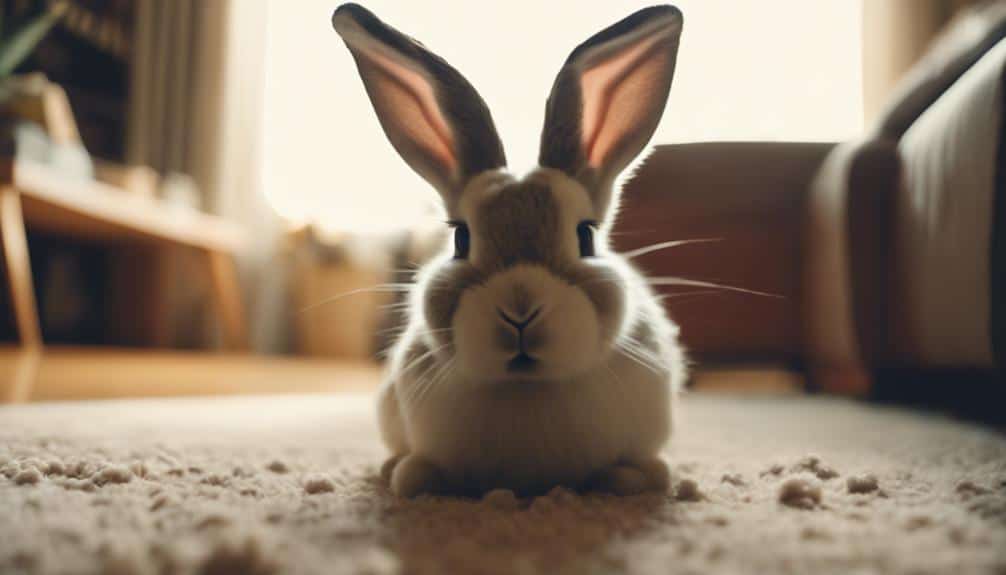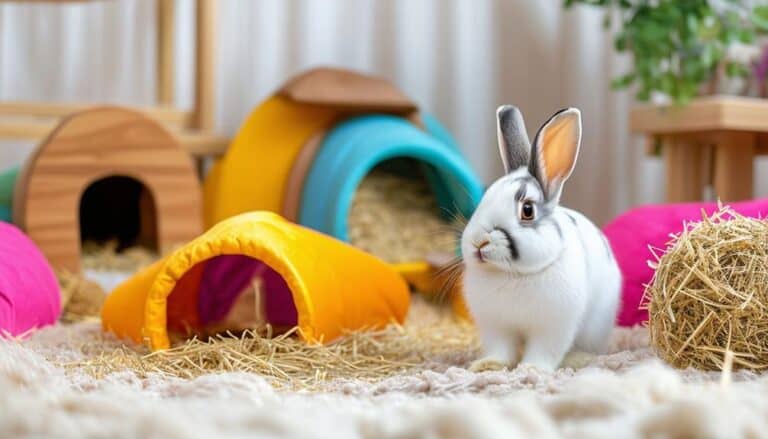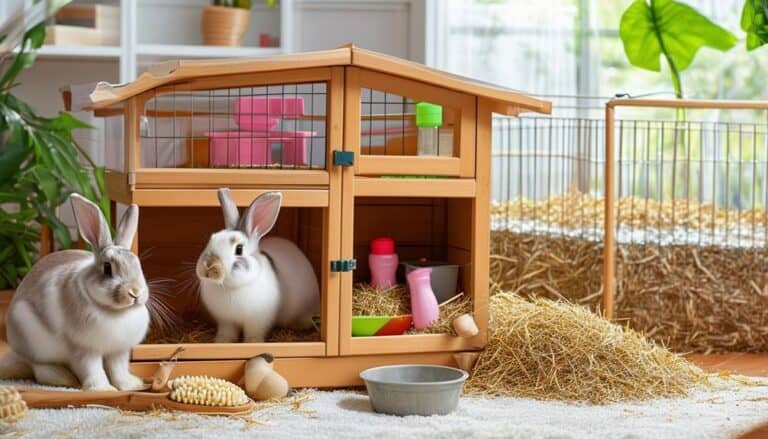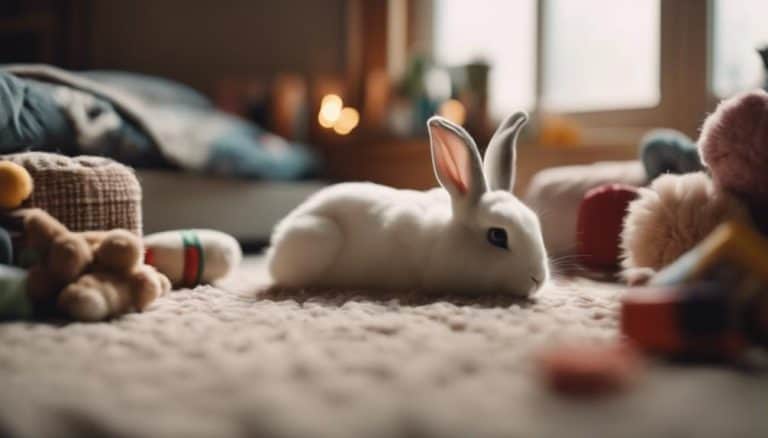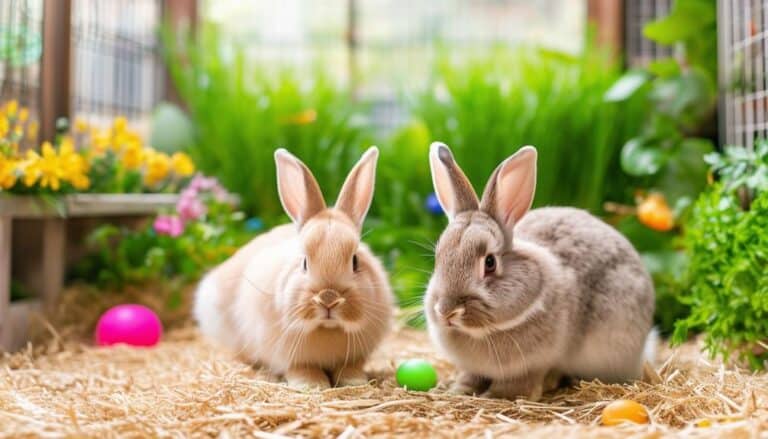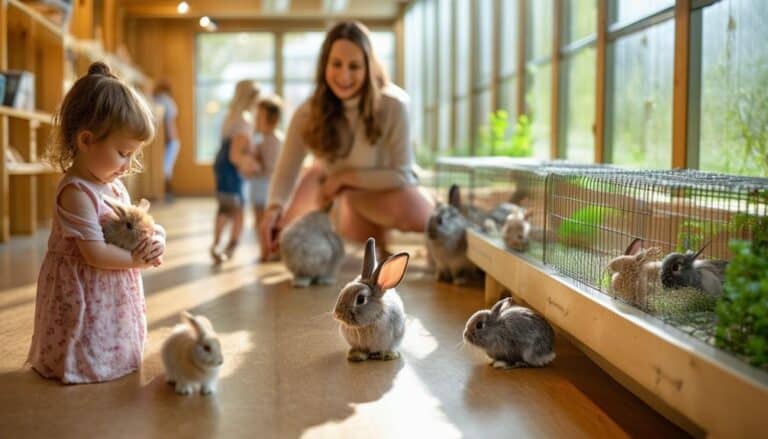Why Does My Pet Rabbit Keep Sniffing?
Have you noticed your pet rabbit constantly sniffing around and wondered why? This behavior is more than just important; it plays several vital roles in their daily life. From exploring their environment to detecting predators, rabbits use their keen sense of smell for various essential tasks.
But there’s more to it than just survival instincts. Why exactly does sniffing help them navigate their world and communicate with other rabbits? Let’s explore the intriguing reasons behind this fascinating behavior and understand how it affects your rabbit’s well-being.
Exploring Their Environment
When your pet rabbit sniffs around, it’s actively engaging in environmental exploration to gather essential sensory information. This behavior is a manifestation of your rabbit’s natural curiosity and a critical part of how they interact with their surroundings. By sniffing, your rabbit can detect subtle changes in the environment, such as new scents or moved furniture, allowing them to understand and navigate their territory effectively.
Sniffing serves multiple purposes. It’s not just about exploration; it’s also a means of communication and territory marking. When your rabbit sniffs you or other objects, it’s gathering information and potentially marking its territory with its scent glands, establishing a sense of ownership and familiarity. This is especially pronounced when there are changes in the environment that may initially cause some disorientation.
To support your rabbit’s exploratory behavior, create a stimulating environment. Introduce safe toys, tunnels, and spaces where they can freely navigate and investigate. This not only satisfies their curiosity but also minimizes excessive sniffing by keeping them engaged and mentally stimulated.
Identifying Threats
Your rabbit’s persistent sniffing often signifies an attempt to detect predatory scents, recognize new surroundings, and assess potential dangers. This behavior is essential for their survival, as their acute sense of smell helps them identify threats quickly.
Detecting Predatory Scents
Rabbits continuously sniff their environment to detect predatory scents, utilizing their acute olfactory senses to identify potential threats and guarantee their safety. As prey animals, rabbits rely heavily on sniffing to gather information about their surroundings. This behavior is a direct manifestation of their survival instincts, allowing them to stay vigilant and respond quickly to any signs of danger.
In your pet rabbit’s environment, sniffing serves as a diagnostic tool, enabling it to differentiate between safe and threatening stimuli. The presence of predatory scents such as those of cats, dogs, or even humans can trigger an instinctual response to remain alert. This heightened state of awareness is essential for a rabbit’s survival in the wild and is deeply ingrained in its behavior.
| Behavior | Clinical Insight |
|---|---|
| Sniffing Continuously | Detecting predatory scents |
| Heightened Vigilance | Response to environmental threats |
| Quick Flee Response | Activation of survival instincts |
Understanding this behavior in your pet rabbit can help you create a safer, more comfortable environment for it. By minimizing potential threats and recognizing the importance of their sniffing habits, you safeguard your rabbit’s well-being and freedom to explore without undue stress.
Recognizing New Surroundings
As pet rabbits navigate new surroundings, their acute sense of smell helps them identify potential threats and establish a sense of security. When your rabbit enters a new environment, its sniffing behavior intensifies. This heightened sniffing is your rabbit’s way of gathering olfactory data about the area. By detecting and analyzing new scents, your pet rabbit can discern whether a space is safe or poses any risks.
Sniffing also plays a vital role in helping rabbits mark their territory. When your rabbit sniffs objects or surfaces, it may also rub its chin or body against them to leave its unique scent behind. This behavior signals to other animals that the area is claimed, enhancing your rabbit’s comfort level in its new surroundings.
Understanding this behavior is essential for providing an environment where your rabbit feels secure. By recognizing that sniffing is a diagnostic tool for your pet, you can better appreciate its need to explore and establish a sense of belonging.
This insight allows you to create a space that minimizes stress and maximizes your rabbit’s comfort level, enabling it to thrive in its new territory.
Assessing Potential Dangers
When a rabbit engages in persistent sniffing, it’s often evaluating its environment for potential threats and predators. This behavior leverages their acute sense of smell, an essential tool for survival. As prey animals, rabbits have evolved to be hyper-aware of their surroundings, and their sniffing is a diagnostic tool to identify potential dangers.
As prey animals, rabbits have evolved to be hyper-aware of their surroundings, and their sniffing is a diagnostic tool to identify potential dangers.
When your rabbit increases its sniffing activity, it’s likely detecting unfamiliar or potentially hazardous scents. This behavior isn’t just random; it’s a systematic way to gather information about the environment. A rabbit’s sense of smell is highly developed, allowing them to pick up on subtle changes that might indicate a threat. For instance, the presence of a predator or even unfamiliar human scents can trigger heightened sniffing.
By understanding this behavior, you can take steps to make sure your rabbit’s environment is safe and secure. Regularly inspect their living area for any new or unusual smells and eliminate potential threats. This might involve removing strong-smelling chemicals, securing the area from predators, or even introducing new objects gradually to avoid overwhelming your pet.
Recognizing and respecting your rabbit’s sniffing behavior can help foster a secure, threat-free environment, promoting their well-being and sense of freedom.
Investigating New Scents
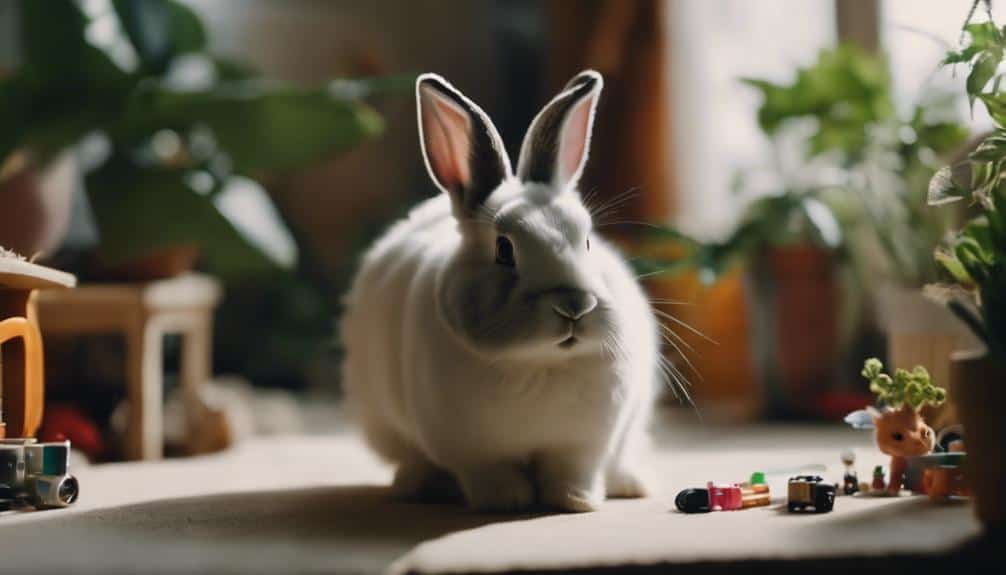
A rabbit’s investigation of new scents is an important behavior that allows them to gather essential information about their environment. Your pet’s sniffing is a diagnostic tool, enabling them to explore and interpret their surroundings.
Rabbits possess a highly developed olfactory system. When new scents are introduced, whether from objects, cleaning agents, or rearranged furniture, your rabbit will likely increase its sniffing activity to become familiar with these changes.
For rabbits, sniffing isn’t just a casual activity; it’s a critical part of their sensory exploration. This behavior helps them map out their environment, identify potential resources, and detect any alterations that might pose a threat or an opportunity.
Introducing varied scents can keep your rabbit mentally stimulated, reducing excessive sniffing that might otherwise arise from boredom or anxiety.
To foster a healthy sniffing environment, consider periodically introducing safe, novel scents and objects. This can include natural elements like untreated wood or herbs. Such stimuli can be both engaging and comforting for your pet, encouraging them to explore confidently.
Marking Their Territory
When your rabbit sniffs and rubs its chin on objects, it’s using scent glands to mark territory. This action helps your rabbit identify familiar spaces, ensuring a sense of security.
Additionally, scent marking establishes social hierarchy, signaling ownership to other rabbits.
Scent Gland Functionality
Rabbits use the scent glands under their chins to mark territory, a behavior that plays an essential role in their social structure and environmental navigation. These scent glands secrete pheromones, which are important for territory marking and communication among rabbits.
When your rabbit rubs its chin on objects, it’s not only claiming ownership but also creating a navigational map of familiar scents. Persistent sniffing behavior often accompanies this scent-marking activity. Your rabbit’s heightened sniffing is an exploratory mechanism to detect new or foreign scents that may need marking.
This behavior ensures that they maintain a well-defined, secure territory. Scent glands play an integral role in their ability to establish and recognize safe zones, enhancing their environmental navigation skills.
Understanding these mechanisms can provide you with diagnostic insight into your rabbit’s behavior. If you notice increased sniffing and chin-rubbing, it could indicate your rabbit is processing new stimuli or reinforcing its territory.
Such behaviors aren’t just instinctual but are embedded in their social and environmental interactions. Recognizing this can help you better manage their habitat and make sure they feel secure and comfortable in their surroundings.
Identifying Familiar Spaces
Consistently, your rabbit’s sniffing and chin-rubbing behaviors serve as vital mechanisms for marking and identifying familiar spaces within their territory. These actions leverage the scent glands located beneath their chins, which release pheromones instrumental in establishing ownership and communication. By marking their environment, rabbits delineate boundaries and create a sense of security.
This territorial marking is essential for several reasons:
- Establishing Ownership: Sniffing and rubbing help your rabbit claim areas, reinforcing their presence.
- Communication: The pheromones left behind serve as signals to other animals, conveying that the space is occupied.
- Security: Familiar scents provide comfort, reducing anxiety and promoting a sense of safety.
- Navigational Cues: Consistent sniffing helps your rabbit map out their territory, making it easier for them to navigate their surroundings.
Understanding these behaviors can greatly enhance your ability to create a stable and secure environment for your rabbit. Recognizing their need for familiar spaces allows you to respect their territorial instincts and promote their well-being. By facilitating their natural communication mechanisms, you contribute to a harmonious and secure habitat.
Establishing Social Hierarchy
To establish their social hierarchy, your rabbit’s persistent sniffing behavior acts as a means of asserting dominance and marking territory within their environment. By engaging in sniffing, rabbits communicate with other rabbits and even humans to solidify their place in the social hierarchy. This behavior plays an important role in their territorial and social interactions.
When a rabbit sniffs, it’s not just exploring; it’s identifying and claiming its personal space or belongings. In new environments or when encountering unfamiliar scents, rabbits will sniff more frequently to establish their presence and dominance. Understanding this sniffing behavior offers insights into your rabbit’s social and territorial dynamics.
Here’s a breakdown of the purposes behind your rabbit’s sniffing:
| Behavior | Purpose | Outcome |
|---|---|---|
| Sniffing new scents | Communication | Establishes dominance |
| Frequent sniffing | Marking territory | Identifies personal space |
| Sniffing other rabbits | Social hierarchy | Asserts or challenges dominance |
Observing your rabbit’s sniffing can reveal much about their interactions and territorial instincts. By interpreting these behaviors, you can better understand and accommodate their need for establishing social hierarchy and maintaining a balanced environment.
Communicating With Other Rabbits

Sniffing, a primary mode of olfactory communication, allows rabbits to convey critical information about identity, health, and social standing within their group. When your rabbit engages in sniffing, it’s not just a random behavior; it’s a sophisticated method of communication. Their keen sense of smell helps them navigate complex social interactions and establish relationships with other rabbits.
Here’s how your rabbit uses sniffing to communicate:
- Identifying Family Members: Through pheromones and scent markers, rabbits can recognize and distinguish familiar individuals within their group.
- Establishing Hierarchies: Sniffing behaviors contribute to determining social ranks, helping rabbits understand their place in the pecking order.
- Detecting Health Status: A rabbit’s sense of smell can detect changes in another rabbit’s health, allowing them to recognize illness or stress.
- Marking Territory: By sniffing and then marking areas with their scent, rabbits communicate boundaries and ownership.
Understanding these sniffing behaviors provides you with diagnostic insights into your rabbit’s social dynamics. By recognizing these subtle cues, you can better interpret your rabbit’s interactions and foster a harmonious environment. This skill set aligns with your desire for freedom by enabling you to facilitate healthier, more natural rabbit relationships.
Checking for Food
Your rabbit’s acute sense of smell drives its frequent sniffing behavior as it searches for food or treats in its environment. This olfactory acuity is crucial for locating sustenance, especially in the wild, where food sources can be scarce and hidden.
When your rabbit persistently sniffs particular areas, it’s often checking for residual scents of food, signaling a previous presence of nourishment. This behavior can be indicative of hunger or simple curiosity.
If your rabbit is sniffing incessantly, it might be time to evaluate its dietary needs. Make sure that it has a consistent supply of fresh hay, vegetables, and occasional treats to satisfy its appetite.
The act of sniffing can also be a sign of your rabbit’s engagement with its surroundings, as it explores and interacts with its environment. Offering small treats or fresh veggies can serve as positive reinforcement for this natural behavior.
It not only satisfies their hunger but also rewards their curiosity, making their environment more stimulating. By understanding and catering to these sniffing patterns, you can safeguard your rabbit’s well-being and enrich its daily life, promoting a healthy and happy pet.
Detecting Predators
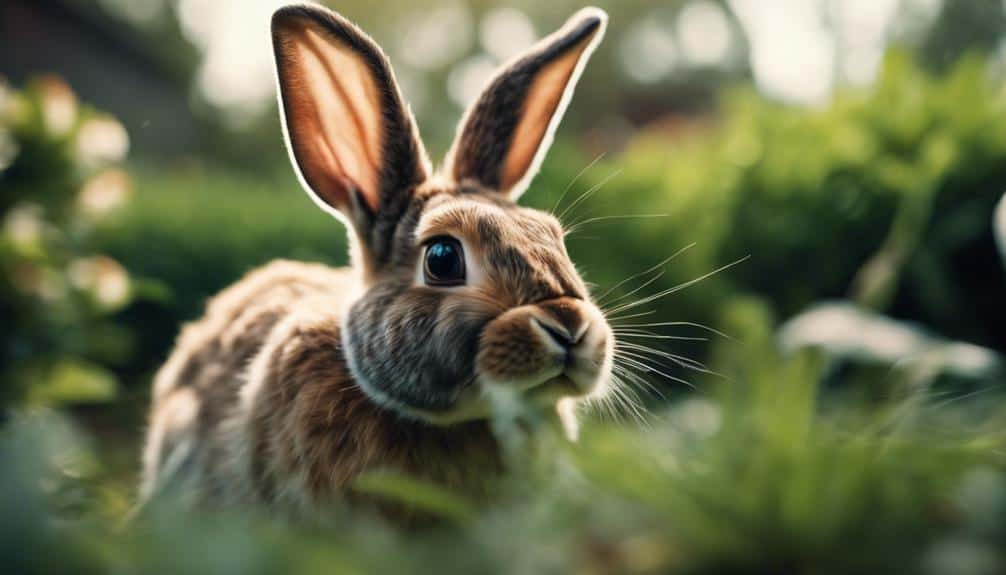
Rabbits rely on their acute sense of smell to detect predators, enabling them to remain vigilant and evaluate potential threats in their environment. This heightened olfactory capability allows your pet rabbit to stay alert and responsive to changes in their surroundings. Sniffing is a manifestation of their natural instinct to guarantee safety from potential dangers.
When your rabbit engages in constant sniffing, it’s actively gathering information to protect itself. Here are key points to ponder:
- Sense of smell: Rabbits have highly developed nasal receptors that can detect even faint traces of predators.
- Predators detection: By continuously sniffing, your rabbit is evaluating the safety of its surroundings, gauging for any lurking threats.
- Alertness: Increased sniffing frequency might indicate your rabbit perceives a potential danger, making it crucial to observe any changes in their behavior.
- Natural instinct: This behavior is ingrained in rabbits as a survival mechanism, ensuring they remain vigilant against predatory threats.
Understanding these behaviors can help you create a safer environment for your rabbit. By recognizing the signs of sniffing as a defensive measure, you can better support your pet’s well-being and freedom.
Familiarizing With Changes
When encountering new scents or objects, a rabbit’s increased sniffing serves as a method to familiarize itself with environmental changes. This behavior isn’t just random; it’s a deliberate process of exploration. Rabbits possess a highly developed sense of smell, which they rely on to gather information about their surroundings. By sniffing, they’re able to detect and analyze new scents, which helps them understand and adapt to recent changes, such as new furniture or unfamiliar objects.
Increased sniffing is also a form of territory marking. Rabbits have scent glands under their chins, and as they sniff, they may rub these glands against objects, leaving their scent behind. This behavior helps them establish a sense of ownership and security in their environment. When you notice your rabbit engaging in this heightened sniffing activity, it’s often a sign they’re acclimating to changes and asserting their presence.
Providing a safe and stimulating environment can help mitigate excessive sniffing. Make sure your rabbit has plenty of interesting objects to explore. This not only satisfies their natural curiosity but also helps them feel more secure, reducing the need for constant sniffing to familiarize with changes.
Natural Rabbit Instincts
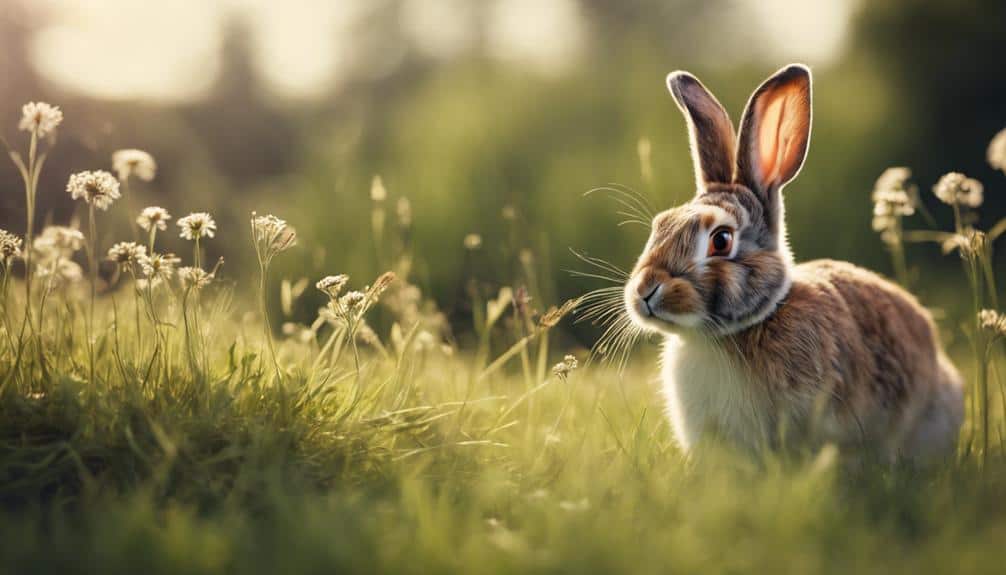
Recognizing that sniffing is a fundamental aspect of a rabbit’s natural instincts, you’ll better understand how this behavior plays a crucial role in their daily life and survival. Sniffing isn’t just a random action; it’s an essential tool that rabbits use to explore their environment and safeguard their well-being.
This behavior is intricately linked to their natural behavior and can be broken down into several critical functions:
- Exploring Environment: Rabbits rely on their keen sense of smell to navigate and familiarize themselves with their surroundings.
- Communication: Through sniffing, rabbits convey information to other rabbits, marking their territory and establishing social hierarchies.
- Identifying Food Sources: Sniffing helps rabbits locate and differentiate between safe and harmful foods.
- Monitoring Well-Being: Changes in sniffing patterns can indicate shifts in a rabbit’s emotional or physical state, providing crucial diagnostic insight.
Conclusion
Your rabbit’s persistent sniffing isn’t just adorable—it’s essential. This behavior helps them explore their environment, identify threats, and investigate new scents.
By marking their territory and communicating with other rabbits, they establish a sense of security. Sniffing also allows them to check for food and detect predators, ensuring their well-being.
Ultimately, it’s a natural instinct that helps them adapt to changes and thrive. Understanding this behavior underscores your role in providing a safe, enriching environment.

